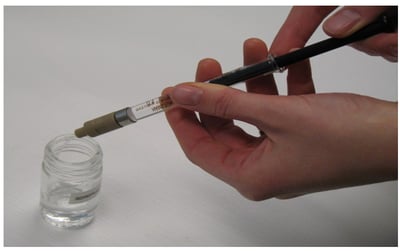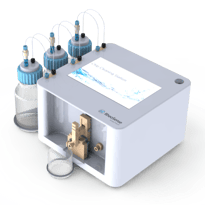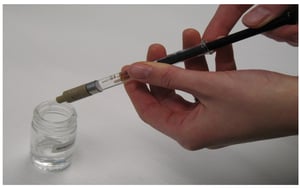The RheoSense m-VROC® is a leading small sample, high shear viscometer ideal for research and development. Capable of the most demanding applications, including small sample protein therapeutics, m-VROC® features the widest dynamic range (high shear rate viscosity measurements up to 1,400,000 s-1) with as little as 50 microliters of sample. Shown below are protocols designed to keep your instrument running optimally, providing you the most accurate data possible.
Loading
The m-VROC® is compatible with multiple syringe sizes (0.1, 0.5, 1, and 10 mL) that can be loaded with your test sample by using a union and plastic needle as shown below. Higher viscosity samples may require loading from the back of the syringe. If any bubbles are present in the syringe upon loading, gently tap the syringe to move bubbles towards the needle-end of the syringe, followed by expelling some solution as well as these bubbles.

Measurements
The image below shows the RheoSense m-VROC® software interface for creating measurement protocols for your sample, whether Newtonian or non-Newtonian. In the box outlined in orange, enter the sample ID, the estimated viscosity, the amount of sample that is loaded into the test syringe, and select the syringe size. The software will update this box to display the estimated remaining sample in your test syringe during measurements. The estimated viscosity is used to calculate the minimum and maximum shear and flow rates for the VROC® cell. The shear rate range you can probe is dependent on your sample viscosity, chip type, and loaded sample volume.
In the measurement input table outlined in red, define the measurement parameters of each segment. After running a test sample, adjust estimated viscosity to determine the shear or flow rate range within 5 – 95 % full scale pressure. Use the “Generate Rate Sweep” and “Generate Temperature Sweep” functions outlined by the green box to automatically populate the measurement input table. Our software algorithm can calculate the measurement and pause times based on the selected shear or flow rates. If you would like to save your measurement protocols for future access, use the “Load/Save Measurement Protocols” function outlined by the purple box here.

Cleaning
Cleaning protocols involve cleaning the single flow path between the test syringe and the chip outlet tube. Use the measurement protocol functionalities shown above to thoroughly clean the sample flow path with a solvent that dissolves your solute. Using a solvent that is incompatible with your solute may lead to flow path and/or chip clogging. Start by running a shear rate corresponding to 5% full scale pressure. After the viscosity reading drops to the viscosity of the solvent, you may increase the shear rate to accelerate the cleaning process and to expel the remaining solvent from the test syringe. If your sample has a high viscosity relative to your cleaning solvent (like oil vs. IPA or heptane), first clean the flow path with a mixture of the high viscosity sample and the solvent. Reload the syringe with the solvent and repeat the cleaning steps mentioned above. Last, repeat with a syringe loaded with IPA or acetone.
We understand that it can be time consuming to clean your chips when measuring immiscible samples. The RheoSense automated Chip Cleaning Station is compatible with our m-VROC viscometer and is designed to clean VROC chips in under 10 minutes! Want to learn more about our automated Chip Cleaning Station and maintaining and monitoring your viscometer chip health? Download our webinar "Best Practices for Maintaining and Monitoring Viscometer Chip Health"! 
Contact us to learn more about the measurement capabilities of the m-VROC®, or to discuss protocol development for your samples and applications!
Written by: Chrystian Ochoa, Application Scientist


